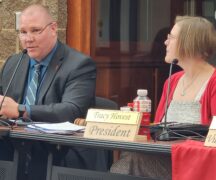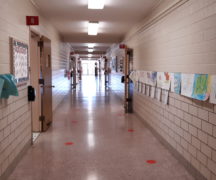By DAVID DUPONT
BG Independent News
David Conley, the Bowling Green school district’s financial advisor, delivered some good news on the financial front at Tuesday’s Board of Education meeting
He’s been telling the school board and the community that they were facing the need for a new operating levy in about two years. That would come on the heels of three levies going before voters for renewal, and when the community will have to vote on a bond to pay for a $40 million elementary building project. Then later down the road, voters will face funding renovations for the high school.
The updated five-year forecast presented by Treasurer Cathy Schuller was showing the effects of some budget trimming of about $2 million, Conley said. That would leave $9.4 million left at the end of the forecast, if those levies are approved. And that did not include any savings in operating costs from having one community elementary school.
Those savings may be enough to avoid that new operational levy, Conley said. This came with a significant “if.”
To avoid the new levy the district’s voters would have to turn three levies into continuing levies. That means once approved those issues would not come back before voters in future. They’d be on the books in perpetuity.
But that also means the state would let the district maintain a smaller fund balance. Now because it relies on $7.1 million in temporary levies which could go away if voters reject them, it needs to maintain a higher fund balance. The district now has about a $13 million balance, and that’s projected to increase by about a $1 million a year in the next couple years.
Right now the district has a 4.2 mill operating levy due to expire in 2020, a $1 million emergency levy also due to expire in 2020, and a 0.5-percent income tax due to expire in 2022. Those three account for $7.1 million in revenue.
Making the emergency levy permanent would require putting it up as a substitute levy. The ballot language for that levy is particularly opaque and would require explaining to voters, Conley said.
However, if that substitute levy were to pass, it would allow the money collected to increase. Now the levy collects $1 million, only. If more taxpayers are added to the rolls, the share of each taxpayer goes down. If the substitute levy is passed. Existing taxpayers would continue to pay the same, and what new taxpayers would add to the revenue generated.
“I’d recommend you do it,” he said. The current approach is “a hindrance” because there’s aways the possibility that the $7.1 million that could go away.
Making the levies continuing would also save the district the $10,000 to $40,000 it costs to go on the ballot.
Sculler also noted in her presentation that the state will no longer help pay for the Homestead and Rollback provisions, which are essentially discounts for taxpayers, on new levies. The state will continue to fund those on levies that are renewed. Making the levies continuing could lock in those discounts for taxpayers.
The voters will still have to vote on the property tax items and a bond to fund the elementary school project by November 2020. The income tax expires in 2022, when, if it were needed, the new property tax would have to be on the ballot.
Superintendent Francis Scruci praised the work of the Board of Education and the facilities and finance citizen committees that met throughout the summer.
They were able to achieve four goals, he said.
The cost of the project was reduced from $72 million to $40 million, albeit without the high school work included.
The length of payback was cut to 30 years from 37 years. In the comment period, resident Ben Otley noted, that will save the district $4.6 million in interest and financing costs.
The method of financing, Scruci said, was changed from property tax only to a split between $20 million, or about 1.76 mills, from property tax, and a .25 percent income tax. That tax would annually generate $325,000 more than needed to pay off the bonds. Those funds could be used to operate and maintain the new school.
And, Scruci concluded, the facilities committee and the school board decided on one community elementary.
“I’ve heard more positive comments than I’ve heard in the last 18 months,” Scruci said.
Some have questioned why the district was starting on the elementary school before renovating the high school. That’s necessary, Scruci said, because the elementary schools were “busting at the seams.”
Two modular classrooms will be placed at Crim this summer, and two more, bringing the total to six, will be placed at Conneaut.
Resident Ken Rieman thanked the board for going forward with the community school. He also has been hearing positive comments.
In terms of financing, the committee members “did the best they could to make it fair for everybody. … It just will not be equal for everybody. We just have to live with that.”
Rieman concluded: “We need to move ahead and put our kids into decent building.”





